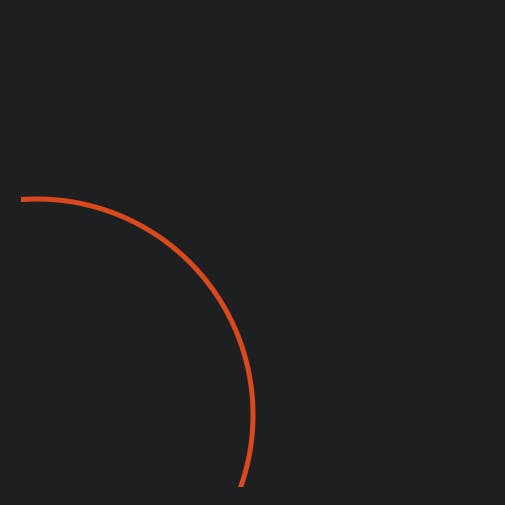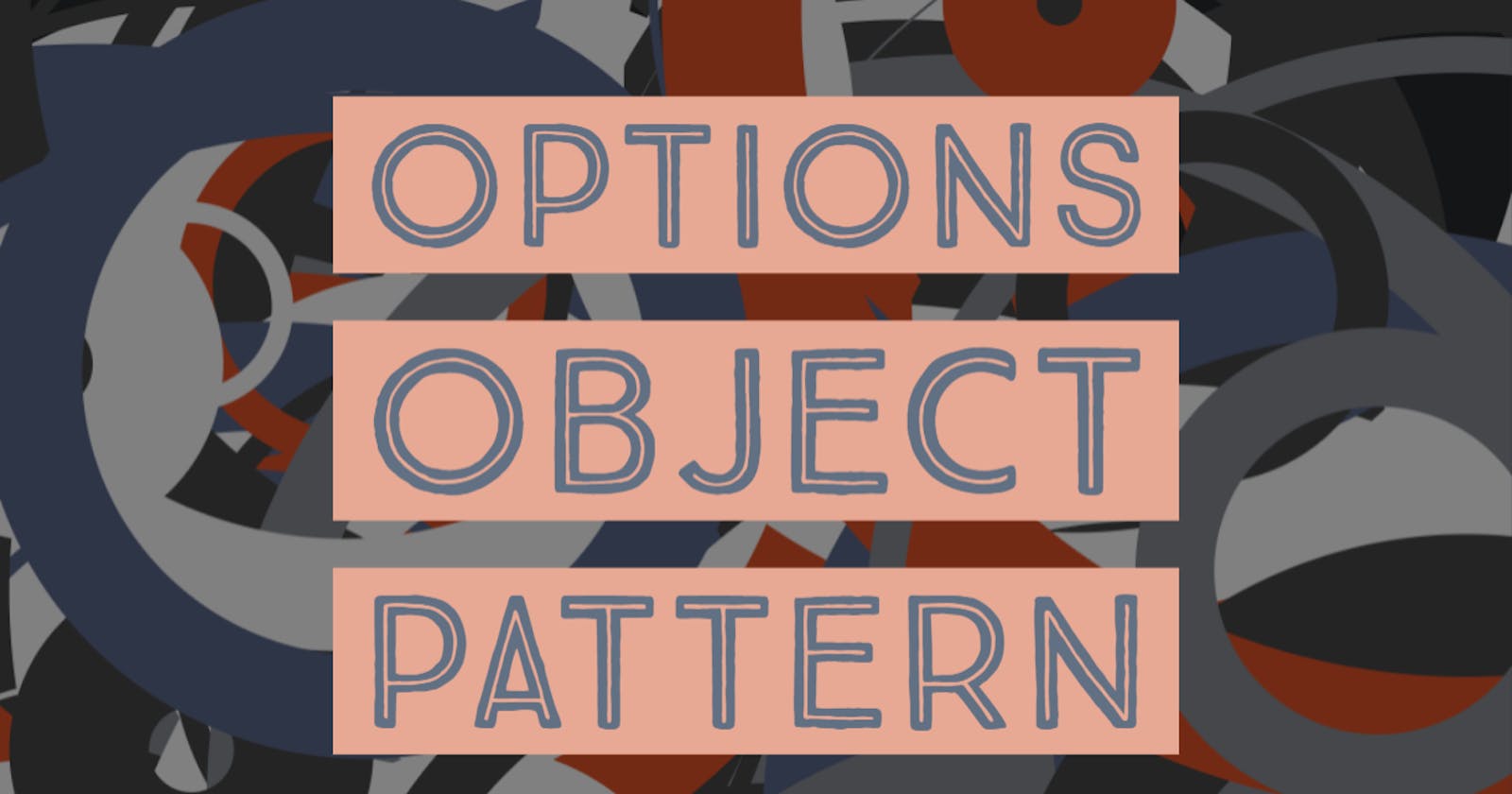An “options object” is a programming pattern that you can use to pass any number of named arguments to a function. Rather than using an ordered list of arguments, you simply pass one argument, which is an object containing named keys for all of your options. Keep reading to learn how and why.

Here, I have created an SVG “sketchpad.”
<div class="container">
<svg id="sketch" class="sketch" viewBox="0 0 500 500">
</svg>
</div>
I’ve given it some basic sizing and color styling.
html { font-size: 22px; }
body { background-color: #1D1F20; }
.container {
text-align: center;
margin: 2rem;
}
.sketch {
width: 500px;
height: 500px;
}
.sketch circle {
fill: none;
}
I want to add some shapes to this sketchpad. I could do this directly in HTML.
<div class="container">
<svg id="sketch" class="sketch" viewBox="0 0 500 500">
<circle cx="250" cy="250" r="228" />
</svg>
</div>
But instead I’m going to create a JavaScript function that builds shapes and appends them to the sketchpad.
const addCircle = (svg) => {
const c = document.createElementNS(
'[http://www.w3.org/2000/svg'](http://www.w3.org/2000/svg'),
'circle'
);
c.setAttribute('cx', 250);
c.setAttribute('cy', 250);
c.setAttribute('r', 228);
c.setAttribute('stroke-width', 44);
c.setAttribute('stroke', '#F06D06');
svg.appendChild(c);
}
I can call this function on the sketchpad to add a circle.
const sketch = document.getElementById('sketch');
addCircle(sketch);
 An orange circle on a dark background
An orange circle on a dark background
Here’s what I have so far.
Now I want to be able to programmatically set the color. I’ll do this by adding another argument to the function, and using that argument when setting the stroke.
const addCircle = (svg, color) => {
const c = document.createElementNS(
'[http://www.w3.org/2000/svg'](http://www.w3.org/2000/svg'),
'circle'
);
c.setAttribute('cx', 250);
c.setAttribute('cy', 250);
c.setAttribute('r', 228);
c.setAttribute('stroke-width', 44);
c.setAttribute('stroke', color);
svg.appendChild(c);
}
I can now call the function with any color I want.
addCircle(sketch, '#525F7F');
 A blue circle on a dark background
A blue circle on a dark background
Here’s the updated function.
What if I want to set even more attributes for the circle? I could keep adding arguments all day.
const addCircle = (svg, color, x, y, r, width) => {}
But having so many arguments can get confusing. Consider that, when calling this function, I would have to remember in which order it expects the arguments.
Instead, I’m going to re-write the function to use the options object pattern.
const addCircle = (options) => {
const c = document.createElementNS(
'[http://www.w3.org/2000/svg'](http://www.w3.org/2000/svg'),
'circle'
);
c.setAttribute('cx', 250);
c.setAttribute('cy', 250);
c.setAttribute('r', 228);
c.setAttribute('stroke-width', 44);
c.setAttribute('stroke', options.color);
options.svg.appendChild(c);
}
This changes how I must call the function.
addCircle({
svg: sketch,
color: '#525F7F',
});
The function call is more verbose but also more clear.
Now I’ll start adding more options.
const addCircle = (options) => {
const c = document.createElementNS(
'[http://www.w3.org/2000/svg'](http://www.w3.org/2000/svg'),
'circle'
);
c.setAttribute('cx', options.x);
c.setAttribute('cy', options.y);
c.setAttribute('r', options.r);
c.setAttribute('stroke-width', options.width);
c.setAttribute('stroke', options.color);
options.svg.appendChild(c);
}
I can call the new function like this.
addCircle({
svg: sketch,
color: '#525F7F',
x: 250,
y: 250,
r: 228,
width: 39,
});
Or I could also do this.
addCircle({
x: 250,
y: 250,
r: 228,
width: 39,
color: '#525F7F',
svg: sketch,
});
Notice the order of the arguments no longer matters. The function finds the correct argument by name.
I could stop here, but it would be nice to have some default options so I don’t have to include a full options object each time I call the function.
const addCircle = (options) => {
const c = document.createElementNS(
'[http://www.w3.org/2000/svg'](http://www.w3.org/2000/svg'),
'circle'
);
c.setAttribute('cx', options.x || 250);
c.setAttribute('cy', options.y || 250);
c.setAttribute('r', options.r || 228);
c.setAttribute('stroke-width', options.width || 39);
c.setAttribute('stroke', options.color || '#D9491D');
options.svg.appendChild(c);
}
Notice all the logical OR operators ( || ). If the options.x value is falsy, the default of 250 is used instead. Same for options.y and so on.
So I can call the function with as few arguments as I want. Any options I don’t specify will fall back on the chosen defaults.
addCircle({
color: '#F4F4F4',
r: 50,
svg: sketch,
});
 A white circle on a dark background
A white circle on a dark background
Here’s the code.
Just for fun — and to test out my new function — I’m going to feed it some random values.
For this, I’m going to add Lodash to the project. I’m going to use its random function on all the circle’s attributes.
addCircle({
x: _.random(0, 500),
y: _.random(0, 500),
r: _.random(0, 250),
width: _.random(0, 50),
svg: sketch,
});
Each time I run the function, it gives me a circle at a random location, with a random size and random width.
 A circle of random shape and color
A circle of random shape and color
I can even randomize the color by adding a list of colors to choose from and having Lodash pick a random one with its sample function.
const colors = [
'#7F8489',
'#F4F4F4',
'#D9491D',
'#3D3D3B',
'#525F7F',
];
addCircle({
x: _.random(0, 500),
y: _.random(0, 500),
r: _.random(0, 250),
width: _.random(0, 50),
color: _.sample(colors),
svg: sketch,
});
 A gray circle on a dark background
A gray circle on a dark background
For even more fun, I’ll create a loop and add ten circles.
let i;
const maxCircles = 10;
for (i = 0; i < maxCircles; i+= 1) {
addCircle({ /* snip */ });
}
 Ten circles of random color, shape, size, and location
Ten circles of random color, shape, size, and location
You can run the code yourself and see what sketch you come up with.
Re-run to get a whole new sketch each time.
Try changing maxCircles to get an even busier sketch. Here’s what one hundred circles looks like.
 One hundred random circles
One hundred random circles
To what other shapes might you apply this pattern? To what other tasks or functions might you apply this pattern? It can be used anywhere you create a function that accepts arguments.

